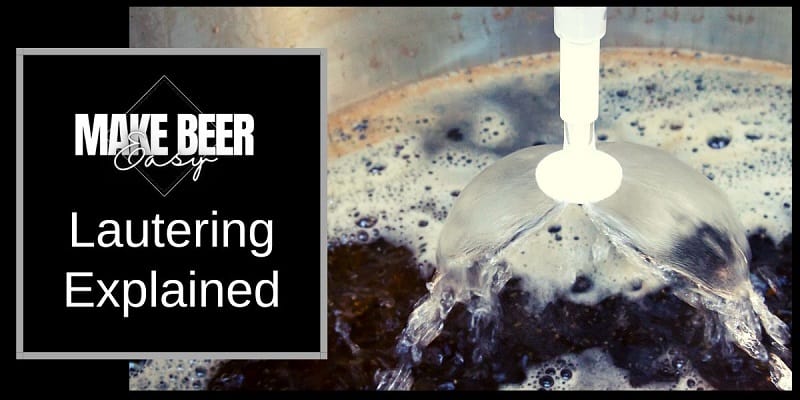When it comes to making beer, lautering is one of the essential steps in the process and a technique a brewer needs to understand and become proficient at in order to make good beer. In this article, we’ll explore the basics of lautering and provide tips on how to lauter the wort to maximize your brewhouse efficiency successfully.
What is Lautering?
Lautering is the process of separating the wort from the spent grains, which is the liquid that contains the sugars extracted from the grains during the mash process; this liquid will later be fermented to create beer. This process is crucial because it ensures that only the sugars and flavors necessary for the beer are extracted, leaving behind the unwanted components. Lautering is typically done in a vessel called a lauter tun, a large container with a false bottom; in the lauter tun, the wort is separated from the grains, leaving behind a solid mass of spent grains.
The Lautering Process
The lautering process is divided into three main stages: mashout, recirculation, and sparging.
During the mashout step, the mash’s temperature is raised to make the wort easier to separate from the grains; this step stops the conversion of starches to sugar and makes the wort less viscous.
Next, the wort is recirculated through the grain bed to clarify it and ensure it is free of debris.
Finally, the sparging process involves rinsing the grains with hot water to extract the sugar from the grains.
Mashout: The First Step of Lautering
Mashout is the first step in the lautering process. During this step, the temperature of the mash is raised to approximately 170°F (77°C) to denature the enzymes that convert starches into sugars. As a result, the wort becomes easier to separate from the grains by stopping the enzymatic process.
Heat water in a separate vessel and add it to the mash tun to accomplish the mashout. Be careful not to add too much water or raise the temperature too quickly, as this can cause the grain bed to compact and make it harder to separate the wort from the grains. Once the desired temperature is reached, let the mash sit for 10-15 minutes to ensure that the denaturing process is complete.
Recirculation: Clarifying the Wort
Recirculation, also called Vorlauf, is the second step in the lautering process. During this step, the wort is circulated through the grain bed to clarify it and remove any debris that may have settled during the mash.

To begin the recirculation process, gently pour the wort over the grain bed, careful not to disturb the grain bed too much. Next, use a sparging arm or a sprinkle nozzle to distribute the wort evenly over the grain bed. Allow the wort to recirculate for approximately 10-15 minutes until it is clear and debris-free.
Sparging: Rinsing the Grains
Sparging is the final step in the lautering process. During this step, the grains are rinsed with hot water to extract as much sugar as possible from the grain bed.
To begin sparging, heat water to approximately 170°F (77°C) and add it to the mash tun. Then, slowly pour the water over the grain bed, using a sparging arm or a sprinkle nozzle to distribute the water evenly. The goal is to rinse the grains without over-saturating them or compacting the grain bed. As the water passes through the grain bed, it extracts the remaining sugars, which are then collected with the rest of the wort.
Once the sparging process is complete, the wort is collected in the brew kettle, where it is boiled, and hops are added. From there, it is fermented and aged to create delicious beer.
Tips for Lautering
For beginners, lautering can be challenging but can become second nature with practice.
The following are some tips to help make the process go smoothly.
Use the right equipment: A lauter tun with a false bottom is essential for lautering. Also, ensure your equipment is clean and free of debris.
Control your water flow: Slow and steady wins the race when it comes to lautering. You want to control the water flow to avoid compacting the grain bed, which can make it difficult to separate the wort from the spent grains.
Monitor your temperature: Keep an eye on the temperature of your mash during the lautering process. If the temperature drops too low, it can cause the wort to become too thick and difficult to separate from the grains.
Last Call
Lautering is an essential step in brewing that separates the liquid wort from the spent grains. By understanding the basics of lautering and following the tips above, beginners can master this important step and create delicious beer at home.
P.S. Be sure to pick up your gift of Big Robb’s top 5 favorite beer recipes from his brewpub. Sign up on the side of the blog or at the bottom if you are on your phone. Cheers!
